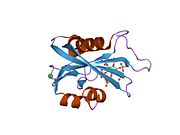- NUDT3
-
Nudix (nucleoside diphosphate linked moiety X)-type motif 3 
PDB rendering based on 2fvv.Available structures PDB 2FVV, 2Q9P Identifiers Symbols NUDT3; DIPP; DIPP-1; DIPP1 External IDs OMIM: 609228 MGI: 1928484 HomoloGene: 31400 GeneCards: NUDT3 Gene EC number 3.6.1.52 Gene Ontology Molecular function • magnesium ion binding
• diphosphoinositol-polyphosphate diphosphatase activity
• hydrolase activityCellular component • cytoplasm Biological process • cell-cell signaling
• diadenosine polyphosphate catabolic process
• diphosphoinositol polyphosphate catabolic processSources: Amigo / QuickGO RNA expression pattern 
More reference expression data Orthologs Species Human Mouse Entrez 11165 56409 Ensembl ENSG00000112664 ENSMUSG00000024213 UniProt O95989 Q9JI46 RefSeq (mRNA) NM_006703 NM_019837.2 RefSeq (protein) NP_006694 NP_062811.1 Location (UCSC) Chr 6:
34.26 – 34.36 MbChr 17:
27.72 – 27.76 MbPubMed search [1] [2] Diphosphoinositol polyphosphate phosphohydrolase 1 is an enzyme that in humans is encoded by the NUDT3 gene.[1][2]
NUDT3 belongs to the MutT, or Nudix, protein family. Nudix proteins act as homeostatic checkpoints at important stages in nucleoside phosphate metabolic pathways, guarding against elevated levels of potentially dangerous intermediates, like 8-oxo-dGTP, which promotes AT-to-CG transversions (Safrany et al., 1998).[supplied by OMIM][2]
References
- ^ Safrany ST, Caffrey JJ, Yang X, Bembenek ME, Moyer MB, Burkhart WA, Shears SB (Jan 1999). "A novel context for the 'MutT' module, a guardian of cell integrity, in a diphosphoinositol polyphosphate phosphohydrolase". EMBO J 17 (22): 6599–607. doi:10.1093/emboj/17.22.6599. PMC 1171006. PMID 9822604. http://www.pubmedcentral.nih.gov/articlerender.fcgi?tool=pmcentrez&artid=1171006.
- ^ a b "Entrez Gene: NUDT3 nudix (nucleoside diphosphate linked moiety X)-type motif 3". http://www.ncbi.nlm.nih.gov/sites/entrez?Db=gene&Cmd=ShowDetailView&TermToSearch=11165.
Further reading
- Safrany ST, Ingram SW, Cartwright JL et al. (1999). "The diadenosine hexaphosphate hydrolases from Schizosaccharomyces pombe and Saccharomyces cerevisiae are homologues of the human diphosphoinositol polyphosphate phosphohydrolase. Overlapping substrate specificities in a MutT-type protein". J. Biol. Chem. 274 (31): 21735–40. doi:10.1074/jbc.274.31.21735. PMID 10419486.
- Yang X, Safrany ST, Shears SB (2000). "Site-directed mutagenesis of diphosphoinositol polyphosphate phosphohydrolase, a dual specificity NUDT enzyme that attacks diadenosine polyphosphates and diphosphoinositol polyphosphates". J. Biol. Chem. 274 (50): 35434–40. doi:10.1074/jbc.274.50.35434. PMID 10585413.
- Fisher DI, Safrany ST, Strike P et al. (2003). "Nudix hydrolases that degrade dinucleoside and diphosphoinositol polyphosphates also have 5-phosphoribosyl 1-pyrophosphate (PRPP) pyrophosphatase activity that generates the glycolytic activator ribose 1,5-bisphosphate". J. Biol. Chem. 277 (49): 47313–7. doi:10.1074/jbc.M209795200. PMID 12370170.
- Strausberg RL, Feingold EA, Grouse LH et al. (2003). "Generation and initial analysis of more than 15,000 full-length human and mouse cDNA sequences". Proc. Natl. Acad. Sci. U.S.A. 99 (26): 16899–903. doi:10.1073/pnas.242603899. PMC 139241. PMID 12477932. http://www.pubmedcentral.nih.gov/articlerender.fcgi?tool=pmcentrez&artid=139241.
- Mungall AJ, Palmer SA, Sims SK et al. (2003). "The DNA sequence and analysis of human chromosome 6". Nature 425 (6960): 805–11. doi:10.1038/nature02055. PMID 14574404.
- Gerhard DS, Wagner L, Feingold EA et al. (2004). "The status, quality, and expansion of the NIH full-length cDNA project: the Mammalian Gene Collection (MGC)". Genome Res. 14 (10B): 2121–7. doi:10.1101/gr.2596504. PMC 528928. PMID 15489334. http://www.pubmedcentral.nih.gov/articlerender.fcgi?tool=pmcentrez&artid=528928.
- Stelzl U, Worm U, Lalowski M et al. (2005). "A human protein-protein interaction network: a resource for annotating the proteome". Cell 122 (6): 957–68. doi:10.1016/j.cell.2005.08.029. PMID 16169070.
- Rual JF, Venkatesan K, Hao T et al. (2005). "Towards a proteome-scale map of the human protein-protein interaction network". Nature 437 (7062): 1173–8. doi:10.1038/nature04209. PMID 16189514.
PDB gallery Categories:- Human proteins
- Chromosome 6 gene stubs
Wikimedia Foundation. 2010.

